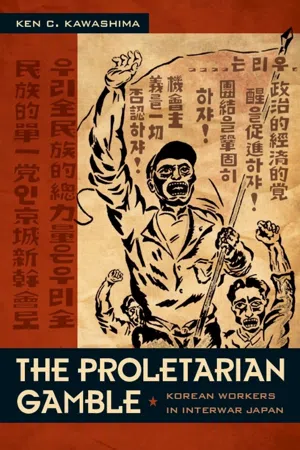
Asia-Pacific: Culture, Politics, and Society
Korean Workers in Interwar Japan
- English
- PDF
- Available on iOS & Android
Asia-Pacific: Culture, Politics, and Society
Korean Workers in Interwar Japan
About This Book
Koreans constituted the largest colonial labor force in imperial Japan during the 1920s and 1930s. Caught between the Scylla of agricultural destitution in Korea and the Charybdis of industrial depression in Japan, migrant Korean peasants arrived on Japanese soil amid extreme instability in the labor and housing markets. In The Proletarian Gamble, Ken C. Kawashima maintains that contingent labor is a defining characteristic of capitalist commodity economies. He scrutinizes how the labor power of Korean workers in Japan was commodified, and how these workers both fought against the racist and contingent conditions of exchange and combated institutionalized racism.
Kawashima draws on previously unseen archival materials from interwar Japan as he describes how Korean migrants struggled against various recruitment practices, unfair and discriminatory wages, sudden firings, racist housing practices, and excessive bureaucratic red tape. Demonstrating that there was no single Korean "minority, " he reveals how Koreans exploited fellow Koreans and how the stratification of their communities worked to the advantage of state and capital. However, Kawashima also describes how, when migrant workers did organize—as when they became involved in R?s? (the largest Korean communist labor union in Japan) and in Zenky? (the Japanese communist labor union)—their diverse struggles were united toward a common goal. In The Proletarian Gamble, his analysis of the Korean migrant workers' experiences opens into a much broader rethinking of the fundamental nature of capitalist commodity economies and the analytical categories of the proletariat, surplus populations, commodification, and state power.
Frequently asked questions
Information
Table of contents
- Contents
- Acknowledgments
- Introduction: The Proletarian Gamble
- 1. The Birth of the Uncontrollable Colonial Surplus: A Prehistory of the Korean Problem
- 2. The Colonial Surplus and the Virtual Pauper
- 3. Intermediary Exploitation: Korean Workers in the Day Labor Market
- 4. Urban Expropriation and the Threat of the Outside: Korean Tenant Struggles against Housing Insecurity
- 5. The Obscene, Violent Supplement of State Power: Korean Welfare and Class Warfare in Interwar Japan
- 6. At the Gates of Unemployment: The Struggles of Unemployed Korean Workers
- Epilogue
- Appendix 1: Korean Self-Help and Social Work Organizations in Japan
- Appendix 2: A Timeline of Anti-Soaikai Activity
- Notes
- Bibliography
- Index